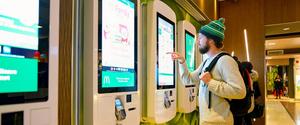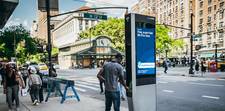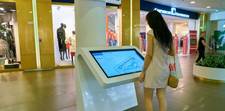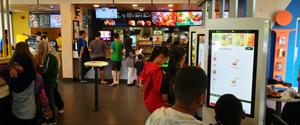Inside and out, and all around the world, digital kiosks are taking over. Typically incorporating touch-enabled screens, these kiosks represent an ideal intersection of appeal and functionality. For all manner of businesses and other entities, it’s possible to create a much better user experience by installing kiosks in key locations.
You can increase sales with self-service kiosks
For retailers and restaurants, a couple of the key benefits of deploying digital kiosks are the associated boosts to efficiency and sales. McDonald’s offers perhaps the highest-profile example of this effect. The company has observed boosts to sales in locations with its interactive digital kiosks, which it expects is related to increased dwell time at the screens and to customers getting an up-close look at all the menu items and customizations on offer.
Other benefits associated with introducing interactive kiosks include reducing service time, minimizing errors in ordering, and more effective upselling. Where under-engaged employees may not upsell as they should, kiosks can incorporate upselling as a matter of course, encouraging customers to purchase additional items that would go well with what they have searched for or selected.
Kiosks deliver information conveniently
For many businesses, there is a pressing demand to share information efficiently. In quick-service restaurants, for instance, any number of patrons may have questions about nutritional and allergy information. In medical establishments, patients may be curious about terminology, tests, or general health practices.
Without any obvious place to turn to, people are likely to bring their questions or concerns to staff. While assisting with these concerns is an important way for an establishment to build stronger ties, interpersonal interaction alone is a suboptimal solution. For one thing, assisting with many basic questions can quickly add up to a significant demand on one’s time. For another, some questions may only be answerable by individuals with a particular level of expertise. Finally, relying solely on a team of employees may disadvantage visitors who genuinely need information, but don’t want to interrupt a busy team with questions.
Digital kiosks are just about perfect as a supplement to, if not an outright replacement for, many of the unofficial Q&A sessions that many businesses have to deal with. Info kiosks placed in lobbies, waiting rooms, or even exam rooms can put company or expert-approved messages just a couple of taps away. It’s a great way to not only free up staff that might otherwise get distracted by questions, but to allow people to self-direct their info-seeking journey.
Digital kiosks offer superior navigation features
Self-service kiosks are also taking off outside of the retail space, employed by cities, shopping centres, hospitals, and other establishments to help people find their way.
Unlike the confusing static maps that used to be the standard, digital kiosks are intuitive, and can provide specific directions that allow individuals to get personalized directions. Rather than the old standby of “You are here,” the directions can assume the user’s perspective, showing the path forward as it would appear to the person standing at the kiosk.
Better still, kiosks can integrate multiple data feeds to provide multiple kinds of directions that an individual might want. A navigation kiosk on the sidewalk, for example, could offer directions and travel times for people travelling by car, bicycle, walking, or transit. It might even include information about the next upcoming departure by whatever modes of transit are nearby.
Example: LinkNYC kiosks across New York City allow users to find their way with free access to Google Maps. This offers access to the full set of directions included in the regular Google Maps app, allowing users to get the right directions for their transportation method of choice.
Kiosks are ideal for delivering advertising
If kiosks deliver good services and are deployed well, people are going to look to them, and seek them out for help completing whatever task they’re looking to accomplish. This makes these kiosks ideal for delivering advertising in a number of interesting and exciting ways.
A kiosk owner might, to start, sell the opportunity to place ads on the wait screen that displays when a kiosk is not in use. Other opportunities can also be explored depending on the nature of the business. A mall might allow stores to pay for access to a featured position in a directory, or for a buyer to pay to brand the look of that directory on a temporary basis. A clinic might allow a wellness or health brand to promote a new product or service of interest to its patients.
Because they are so effective at drawing attention, any owners who do not implement advertising on their kiosks are typically leaving a significant amount of money on the table. Some kiosks, such as the LinkNYC Links that offer WiFi, directions, and other services to people on the streets of New York City, fund themselves entirely through advertising, leaving users to enjoy access to useful services for free without emptying the coffers of the owners.
People really like digital kiosks
It seems that it doesn’t matter which environment they’re in; people love using digital kiosks to find information and complete transactions themselves. A survey by Bouncepad found that 61% of consumers wanted self-service as an option when interacting with businesses. The trend seems to be extending even to restaurants, where reception to self-service options was mixed early on. A Market Force Information survey found that where just 30% of respondents had recently used tech-enabled ordering in 2015, that number climbed to 62% by 2018.
In other words, the benefits of incorporating kiosks goes beyond the various enhancements to functionality and to the heart of meeting shifting consumer demands. Investing in good kiosks now can help set you up for a future in which self-service and on-demand access are the norm.
Do you want to deploy profitable kiosks that people love?
Learn how Broadsign can help!









